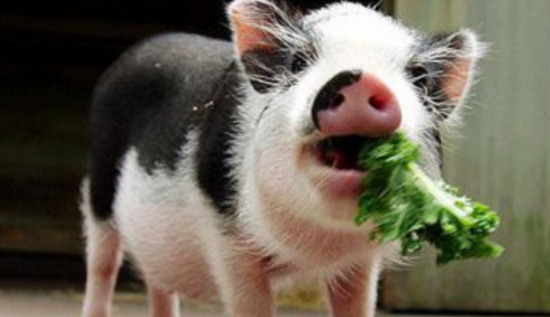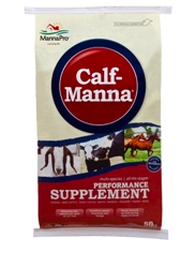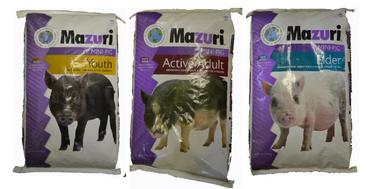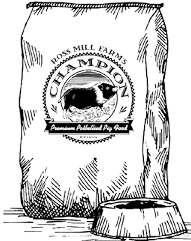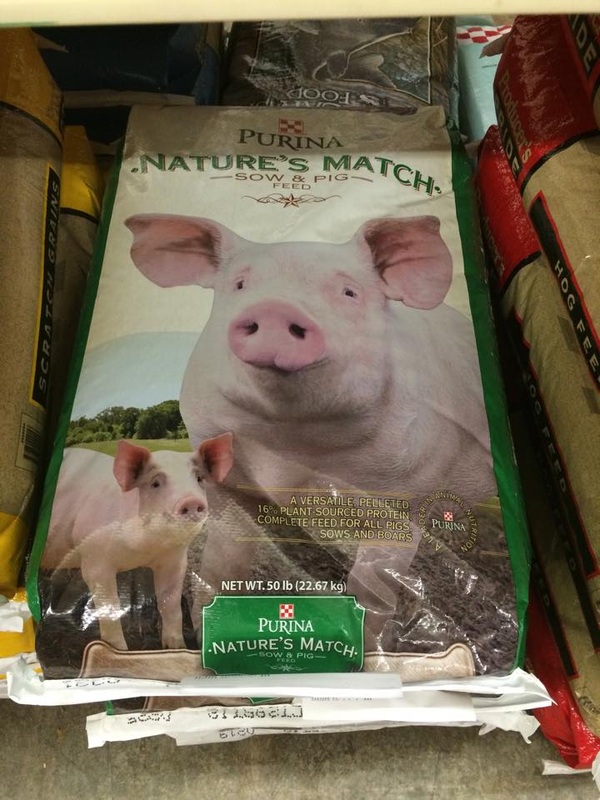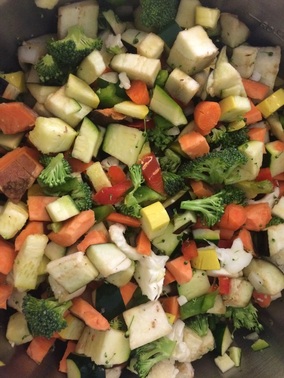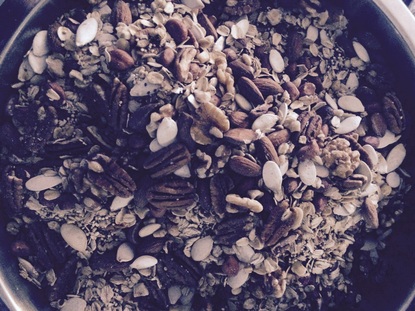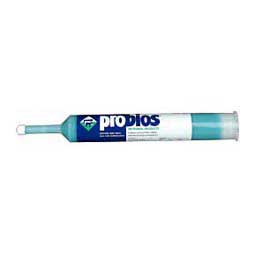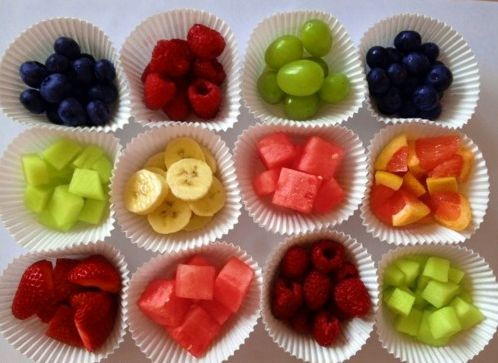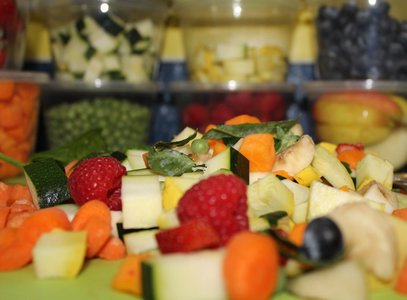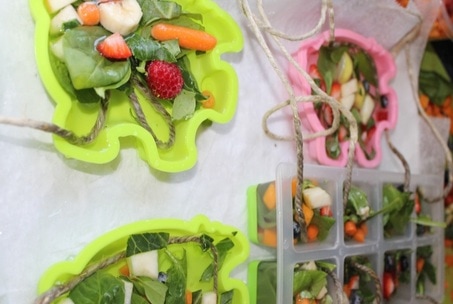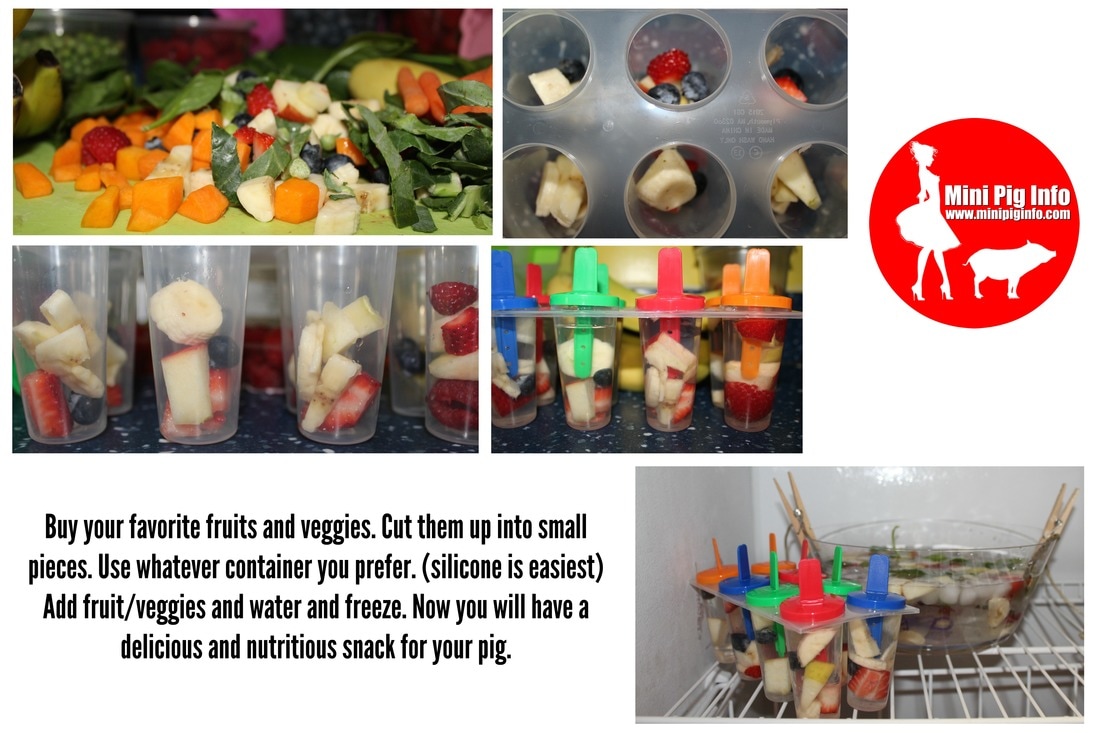Mini Pig Nutrition
What Should Your Pig Be Eating?
|
Because it is virtually impossible to list every food and its nutritional value, we would like to introduce you to a link that can tell you the nutrient amount in each food. http://ndb.nal.usda.gov/searchnutrition. You scroll to the desired mineral/vitamin measurement desired and click go. The website does the calculation for you.
|
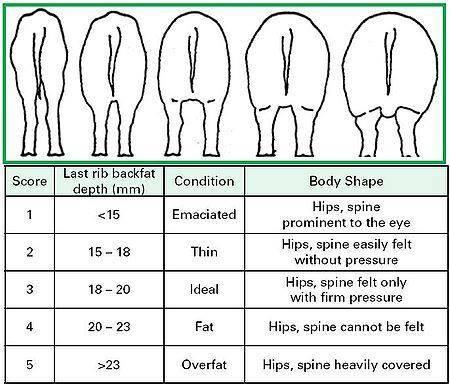 This chart should be used in pigs over a year old. Piglet sizes should NOT use these guidelines to gauge appropriate size or body shape. This chart should be used in pigs over a year old. Piglet sizes should NOT use these guidelines to gauge appropriate size or body shape.
DIET-
That dreaded four letter word! Everyone is always concerned about feeding their pig too much or too little. For this reason along diet is one of the most discussed topics that there is! If you look into our lives as humans diet is also one of our main focuses as well, so why wouldn't you care about the food that goes into your beloved piggies. When you take you pig to the vet or your vet comes to see your pig, talk to them about everything thats going on including nutrition. If you aren't having a conversation with your vet about what you’re feeding your pig and how much you’re feeding him, you’re missing an important step to preventative health care and also an opportunity to have a professional guide you. Starving your pig vs overfeeding and where is the fine line you ask? Would you feed your child a diet that limits their muscle or bone growth? No way, so why would you do that to your pig? Most mini pig foods are the best suited diet for our pigs. The manufactured mini pig pellets have essentials vitamins and minerals in them that sometimes are difficult to obtain with a natural diet however it can be accomplished. So now that you know the types of mini pig food (see pictures on the left) what do you feed and how much?? Feeding is on an individual preference is the best way to put it. All feeds have positive and negatives and some of the most talked about are Mazuri vs Pig and Sow. Best thing to keep in mind when it comes to our pigs is the fact that YOU know your pig best! No matter which food you pick there is a MINIMUM feeding that you should NEVER go under! Suggested amounts are typically written on the bags of feed themselves. The general rule of thumb is a % of their IDEAL body weight, not how much they currently weigh, but what a pig of their height and length SHOULD way. MINIMUM Up to 25 lbs -1/4 cup 2 x a day pellets (no matter the mini pig brand) -healthy size salad *greens *veggies -healthy daily snacks 25lbs and over - 2% pigs ideal weight in pellets (no matter the mini pig brand) -healthy size salad *greens *veggies -healthy daily snacks Every pig is different and needs food catered to their body and physical activity. With that in mind, making sure they have that well balanced diet is key! As I always say "green veggies-GO!" Balance out snack versus meals and keep in mind proportions. Know that fruits, although are tasty, are as high in sugar as starchy vegetables. With that being said, it doesn't mean you can't feed them these foods, just remember it is all about moderation for everything in life! There are body scoring charts listed on our website to help you determine if your pigs body shape is unhealthy or ideal. (Click here to view that page) The ideal number is a solid 3-3+. You shouldn't be able to physically see spine or hip bones and pigs should have a well rounded backside. If you notice your pig is quickly gaining weight, you may need to cut back on the amount you're feeding, if you notice your pig is not gaining weight, you may need to increase the amount you're feeding. How do you know if your pig is unhealthy? We have a page dedicated to that as well! You can click here to learn more about body scoring and deal body weight. In order to have a healthy pig, you need to be aware of what is being ingested. Measure your pigs food. If the goal is 2 cups of pellets daily in addition to 1 cup of vegetables, measure out that amount and only use that amount. This is especially important when you are a 1st time pig parent. It is very easy to overfeed pigs, especially since they always act like they're starving. In the wild, pigs eat what they can find. There aren't many overweight feral pigs and that is because they are always on the move and they have to literally work for their food, it isn't put in a bowl to make it easier for them. Taking your pre-measured amount of food and allowing them the opportunity to eat it throughout the day versus 2 bigger meals seems to have benefits. This is more like what would happen in their natural environment where they would search and search and finally find something edible and search and search again until they find something else. Foraging for food is a natural instinct. So, if you are able to offer a diet like that (meaning multiple smaller meals instead of 2 bigger ones), you will likely have a much happier pig. This isn't realistic for many who work during the day, and that's ok, 2 bigger meals is perfectly appropriate as well. Just something to consider. |
If you feel you need help with an assessment on your pigs size or proper nutrition for your pig as always feel free to email us! We are always here to help! A healthy pig is a happy pig!
There are several major pig feed manufacturers and typically, those brand-name feed companies feed are fairly comparable to each other, it's more about convenience and preference. I had the privilege of having a conference call with the head nutritionist for Purina pig and sow, and as many of us know, Purina does own the Purina products as well as the Mazuri brand pig feed. Per the conversation I had with the nutritionist and her colleagues from Purina, Purina does recommend Mazuri mini pig feed for the pet pigs that we have. I'll share a few things that I learned during that conference call, MSG is being removed from the feed beginning March 15, 2015 in addition they are also adding soy oil to the feed due to the ongoing common dry skin problems that the parents have. Something new I learned when I spoke with them, is that the raw ingredients of their feed, is tested on a daily basis and slight changes to their formulary is made on a daily/weekly basis in order to supplement with slight modifications to additives in order to balance the diet. Purina pig and sow is produced for production pigs it is designed to be complete nutrition for these pigs. Mazuri feed, however, is designed for many pigs or pet pigs. The Mazuri diet is formulated to be added to foods that a pig Parent may be given their pet pig such as vegetables treats or fruits. Other well-known pig feed manufacturers are MannaPro and champion brand by Ross mill farms. A lot of people add water to the feed, and thats fine, pigs need hydration, but use warm or cold water versus hot water. Hot water can damage the integrity of the feed and essentially kill off some of the vitamins and nutrients that are added.
In addition to the formulated diet, you can feed a good variety of fresh vegetables to make up about 25% of the pig's diet. Foods such as celery, cucumbers, peppers, carrots, potatoes and some greens are good choices (but try to limit the starchy vegetables like potatoes). Some fruits can be feed as well but only in moderation due to the high sugar content. Most pigs love treats like apples, grapes and raisins, but these are good to reserve as treats to be used in training.
Another option for pig parents is an all natural diet.
An all natural diet is a personal choice, but some basic foods need to be included in order to ensure all the vital nutritional components are fulfilled. You can add any of these to a pelleted diet as well. Protein rich foods include: almonds, peanuts, beechnuts, Brazil nuts, butternuts, cashews, flaxseed, hazelnuts, sunflower seeds, pumpkin seeds, pecans, sunflower seeds and walnuts to name a few. Cereal grains like oats, quinoa, brown rice, oat bran, wheat bran, barley, corn and hominy. Beans (cooked, not raw) including kidney beans, Lima beans, navy or pinto beans. Vegetables can include carrots, broccoli, brussel sprouts, cabbage, celery, cauliflower, lettuce, onions, peas, peppers, corn, eggplant, kale, spinach, squash, zucchini, sweet potatoes and pumpkin. You can click here to learn more about an all natural diet.
Some vegetables can be fed in larger quantities if they are low in calories; these include cucumbers, celery, lettuce, bell peppers, cabbage, broccoli, and green beans. Pigs find delicious many vegetable parts that we normally throw away. Keep a plastic container in your refrigerator to hold peelings and cores of cabbage, lettuce, apples, melons, tomatoes, eggplant, bell peppers, potatoes, squash, and carrots. Feed the starchy vegetables with discretion. Pigs love banana peels, but do not feed citrus peels. Other fruits and vegetables pigs love are: bananas, peaches, pears, melons, corn (feed sparingly), tomatoes, eggplant, boiled onions, plums, and peeled citrus.
Good training treats are apple slices, grapes, raisins, frozen peas, and raw peanuts (in or out of the shell) .
There are many foods that are a nutritious and healthy alternative for your pig. Not all pigs like everything that's good for them. And if given the opportunity, pigs will go for what tastes good and that's not usually the most nutritious option if there is a choice. It's good to give a mixture and soon enough you will find out what your pigs likes and dislikes are and you can change or cater your pigs diet accordingly. They'll need a well balanced diverse diet if the all natural diet is the choice you make with supplements for the ingredients that are essential for overall health. Click here to visit the USDA website regarding the amount of nutrition in different specific foods. http://ndb.nal.usda.gov/ndb/search. You can search for the nutritional content of any food by using that link.
There are several major pig feed manufacturers and typically, those brand-name feed companies feed are fairly comparable to each other, it's more about convenience and preference. I had the privilege of having a conference call with the head nutritionist for Purina pig and sow, and as many of us know, Purina does own the Purina products as well as the Mazuri brand pig feed. Per the conversation I had with the nutritionist and her colleagues from Purina, Purina does recommend Mazuri mini pig feed for the pet pigs that we have. I'll share a few things that I learned during that conference call, MSG is being removed from the feed beginning March 15, 2015 in addition they are also adding soy oil to the feed due to the ongoing common dry skin problems that the parents have. Something new I learned when I spoke with them, is that the raw ingredients of their feed, is tested on a daily basis and slight changes to their formulary is made on a daily/weekly basis in order to supplement with slight modifications to additives in order to balance the diet. Purina pig and sow is produced for production pigs it is designed to be complete nutrition for these pigs. Mazuri feed, however, is designed for many pigs or pet pigs. The Mazuri diet is formulated to be added to foods that a pig Parent may be given their pet pig such as vegetables treats or fruits. Other well-known pig feed manufacturers are MannaPro and champion brand by Ross mill farms. A lot of people add water to the feed, and thats fine, pigs need hydration, but use warm or cold water versus hot water. Hot water can damage the integrity of the feed and essentially kill off some of the vitamins and nutrients that are added.
In addition to the formulated diet, you can feed a good variety of fresh vegetables to make up about 25% of the pig's diet. Foods such as celery, cucumbers, peppers, carrots, potatoes and some greens are good choices (but try to limit the starchy vegetables like potatoes). Some fruits can be feed as well but only in moderation due to the high sugar content. Most pigs love treats like apples, grapes and raisins, but these are good to reserve as treats to be used in training.
Another option for pig parents is an all natural diet.
An all natural diet is a personal choice, but some basic foods need to be included in order to ensure all the vital nutritional components are fulfilled. You can add any of these to a pelleted diet as well. Protein rich foods include: almonds, peanuts, beechnuts, Brazil nuts, butternuts, cashews, flaxseed, hazelnuts, sunflower seeds, pumpkin seeds, pecans, sunflower seeds and walnuts to name a few. Cereal grains like oats, quinoa, brown rice, oat bran, wheat bran, barley, corn and hominy. Beans (cooked, not raw) including kidney beans, Lima beans, navy or pinto beans. Vegetables can include carrots, broccoli, brussel sprouts, cabbage, celery, cauliflower, lettuce, onions, peas, peppers, corn, eggplant, kale, spinach, squash, zucchini, sweet potatoes and pumpkin. You can click here to learn more about an all natural diet.
Some vegetables can be fed in larger quantities if they are low in calories; these include cucumbers, celery, lettuce, bell peppers, cabbage, broccoli, and green beans. Pigs find delicious many vegetable parts that we normally throw away. Keep a plastic container in your refrigerator to hold peelings and cores of cabbage, lettuce, apples, melons, tomatoes, eggplant, bell peppers, potatoes, squash, and carrots. Feed the starchy vegetables with discretion. Pigs love banana peels, but do not feed citrus peels. Other fruits and vegetables pigs love are: bananas, peaches, pears, melons, corn (feed sparingly), tomatoes, eggplant, boiled onions, plums, and peeled citrus.
Good training treats are apple slices, grapes, raisins, frozen peas, and raw peanuts (in or out of the shell) .
There are many foods that are a nutritious and healthy alternative for your pig. Not all pigs like everything that's good for them. And if given the opportunity, pigs will go for what tastes good and that's not usually the most nutritious option if there is a choice. It's good to give a mixture and soon enough you will find out what your pigs likes and dislikes are and you can change or cater your pigs diet accordingly. They'll need a well balanced diverse diet if the all natural diet is the choice you make with supplements for the ingredients that are essential for overall health. Click here to visit the USDA website regarding the amount of nutrition in different specific foods. http://ndb.nal.usda.gov/ndb/search. You can search for the nutritional content of any food by using that link.
Inappropriate Foods For Your Mini Pig
Inappropriate things to feed your pig include cat or dog food, meat, alcoholic beverages, chocolatey or salty foods, candy or sugary treats, acorns, dairy products or poisonous plants in your yard or home. Please see the list of toxic plants under things known to be toxic to your pig*
Some foods are quite simply empty calories. No nutritional value at all.
One of the most frequently asked questions is which brand of feed is best.
I have actually spoke to the head nutritionist at Purina who also owns the Mazuri brand. Champion by Ross Mill Farms is another popular brand as is Manna Pro. Each one of these brands is similar in its' make up. Purina was designed to be the only source of nutrition for production pigs, it is not recommended for mini pigs. Mazuri is the recommended feed for mini pigs according to their experts. Mazuri was designed to work in collaboration with fresh fruits and veggies, along with treats and is not designed to be the only source of nutrition. Some pig rescues (like Gallastar Therapeutic Riding in Virginia) mill their own feed and sell it as well. Picking a brand is a personal choice, some say the coat of their pig looks better on a particular brand while others have a different opinion. Mazuri is the only brand I am aware of that has different variations for the stages of life, I personally like that. I also like that it's widely available at most feed stores. Some of the others have to be shipped to your home and that can get pricey, but I will say, if you're not having any issues with the brand of feed you're currently using, don't switch it because of someone else's experience. Each pig will have a different experience and because someone else has a good result with a particular feed, it doesn't mean you will also. As long as your pigs diet balances their activity level, you are doing good. If you see your pig is gaining a lot of weight, you may want to reconsider the feed or portions/amount being fed. Check out the page dedicated to helping you find that balance by clicking here.
Sources:
http://www.merckmanuals.com/vet/management_and_nutrition/nutrition_pigs/nutritional_requirements_of_pigs.html
http://www.highproteinfoods.net
http://www.pighealth.com
http://pigsfood.com/organic-pig-foodfeed/
If you'd like to research more about the nutritional needs of your pig, here is a GREAT link:
http://www.ncsu.edu/project/swine_extension/nutrition/nutritionguide/default.htm
Written By Brittany Sawyer and Nicole Cox 03/2015
revised 08/2015
Some foods are quite simply empty calories. No nutritional value at all.
One of the most frequently asked questions is which brand of feed is best.
I have actually spoke to the head nutritionist at Purina who also owns the Mazuri brand. Champion by Ross Mill Farms is another popular brand as is Manna Pro. Each one of these brands is similar in its' make up. Purina was designed to be the only source of nutrition for production pigs, it is not recommended for mini pigs. Mazuri is the recommended feed for mini pigs according to their experts. Mazuri was designed to work in collaboration with fresh fruits and veggies, along with treats and is not designed to be the only source of nutrition. Some pig rescues (like Gallastar Therapeutic Riding in Virginia) mill their own feed and sell it as well. Picking a brand is a personal choice, some say the coat of their pig looks better on a particular brand while others have a different opinion. Mazuri is the only brand I am aware of that has different variations for the stages of life, I personally like that. I also like that it's widely available at most feed stores. Some of the others have to be shipped to your home and that can get pricey, but I will say, if you're not having any issues with the brand of feed you're currently using, don't switch it because of someone else's experience. Each pig will have a different experience and because someone else has a good result with a particular feed, it doesn't mean you will also. As long as your pigs diet balances their activity level, you are doing good. If you see your pig is gaining a lot of weight, you may want to reconsider the feed or portions/amount being fed. Check out the page dedicated to helping you find that balance by clicking here.
Sources:
http://www.merckmanuals.com/vet/management_and_nutrition/nutrition_pigs/nutritional_requirements_of_pigs.html
http://www.highproteinfoods.net
http://www.pighealth.com
http://pigsfood.com/organic-pig-foodfeed/
If you'd like to research more about the nutritional needs of your pig, here is a GREAT link:
http://www.ncsu.edu/project/swine_extension/nutrition/nutritionguide/default.htm
Written By Brittany Sawyer and Nicole Cox 03/2015
revised 08/2015
Benefits Of Pumpkin For Mini Pigs
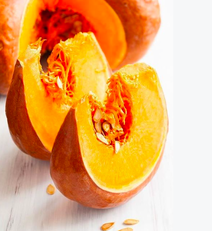
Benefits of pumpkins which many of us know are good for pigs, just not why...
Pumpkin is a very low calorie vegetable (actually technically a fruit) that is packed with antioxidants such as vitamins A, C, E, beta-carotene, and zea-xanthin which can help prevent age-related macular disease. Pumpkin is also a rich source of B-vitamins such as folates, niacin, thiamin, and pantothenic acid and minerals like calcium, copper, potassium, and phosphorus. It is an excellent food for aiding weight loss and for reducing cholesterol. The high amount of phytonutrients in pumpkin have been shown to help prevent the risk of cancers, particularly mouth, lung, and colon cancer. Pumpkin also contains several anti-aging benefits and the antioxidants help to keep skin wrinkle-free and radiating a healthy glow. It also contains immune-boosting properties which can help the body stay strong and ward off common colds and flus that may be going around. Pumpkin is excellent way to replenish and restore the body after a workout as it is high in potassium which helps to restore the body’s balance of electrolytes after exercise and keeps muscles functioning at their best. Pumpkin is a versatile food and can be eaten raw, steamed, baked, or roasted and is commonly used in muffins, pies, soups, and stews. Frozen or canned pumpkin is an alternative option to include this healthy vegetable into your diet when you are short on time. Pumpkin can be found online and fresh at your local health food store. This is 100% pure pumpkin, not pumpkin mix...
Pumpkin is a very low calorie vegetable (actually technically a fruit) that is packed with antioxidants such as vitamins A, C, E, beta-carotene, and zea-xanthin which can help prevent age-related macular disease. Pumpkin is also a rich source of B-vitamins such as folates, niacin, thiamin, and pantothenic acid and minerals like calcium, copper, potassium, and phosphorus. It is an excellent food for aiding weight loss and for reducing cholesterol. The high amount of phytonutrients in pumpkin have been shown to help prevent the risk of cancers, particularly mouth, lung, and colon cancer. Pumpkin also contains several anti-aging benefits and the antioxidants help to keep skin wrinkle-free and radiating a healthy glow. It also contains immune-boosting properties which can help the body stay strong and ward off common colds and flus that may be going around. Pumpkin is excellent way to replenish and restore the body after a workout as it is high in potassium which helps to restore the body’s balance of electrolytes after exercise and keeps muscles functioning at their best. Pumpkin is a versatile food and can be eaten raw, steamed, baked, or roasted and is commonly used in muffins, pies, soups, and stews. Frozen or canned pumpkin is an alternative option to include this healthy vegetable into your diet when you are short on time. Pumpkin can be found online and fresh at your local health food store. This is 100% pure pumpkin, not pumpkin mix...
Susan, President of Ross Mill Farms talks about appropriate ways to feed your pig in this Howcast video:
http://www.howcast.com/videos/516065-how-to-feed-your-potbellied-pig-pet-pigs/
http://www.howcast.com/videos/516065-how-to-feed-your-potbellied-pig-pet-pigs/
Probiotics May Help Support Your Pet’s GI Tract
Probiotics and the benefits of use.
Probiotics are live microorganisms. When ingested, they may help support a healthy GI tract. They also promote:
• Immune health
• Digestive health
• Stool quality
However, while the use can be beneficial, it can also lead to other problems. Commonly used in animals with digestive problems, probiotics have been suggested many times for pet pig owners. Commercially sold probiotics aren't regulated. As a matter of fact, tests of 13 probiotic products showed that only two contained the number of probiotic organisms advertised. Some "contained as little as 7% to 58% of the label claim. What's part of the reason for the discrepancy? It's hard for beneficial bacteria to survive weeks or months on a store shelf. Even if they do, the bacteria then have to survive their trip through your pet's stomach acids and bile salts in order to successfully make it to the gastrointestinal tract.
To deal with these problems, some pet probiotic producers now microencapsulate their bacteria to help protect them, says Wortinger, while others deliver a wider array of bacteria within a single product to improve effectiveness.
Talk to your veterinarian if you think probiotics might help your dog or cat. Your vet can probably recommend products they are familiar with that have had good results.
Probiotics, or “good bacteria,” can be defined as living microorganisms that, when administered in adequate amounts, can offer multiple health benefits to the host. Though they have been gaining popularity amongst humans in the past decade, the possibility of similar probiotic supplements for your pets’ health is on the rise.
“Essentially, we are trying to give live bacteria in supplement form that have beneficial properties to an animal in order to improve their digestive health,” said Dr. Jan Suchodolski, clinical associate professor at the Texas A&M College of Veterinary Medicine & Biomedical Sciences. “It is imperative that bacteria are alive once they reach the gut and that they are also delivered in high amounts. That’s why a high-quality product is needed.”
In order to fully understand how probiotics work, it’s important to know that the beneficial effects of probiotics are bacterial strain specific, meaning every bacterial strain has a potentially different effect. Some probiotic strains, for instance, stimulate the immune system, while other strains produce anti-inflammatory biomolecules or antimicrobial molecules to combat pathogens.
“This is an area of active ongoing research, as all probiotic strains have to be evaluated for their mechanism, and only once the mechanism is identified can we identify which probiotic strain should be given in which disease,” said Dr. Suchodolski.
There are several studies proving that specific probiotic strands are useful for specific diseases, and Dr. Suchodolski explains that the strongest of this data is available for preventing stress diarrhea in pets. However, a few selected products have also been shown to have anti-inflammatory properties and may be useful in chronic Gastrointestinal (GI) diseases.
“Dogs or cats that receive probiotics have a lower incidence of diarrhea compared to animals not receiving it,” Dr. Suchodolski said. “The best effects are observed when probiotics are given in advance in anticipation of stressful events, for example boarding flights, long car rides, etc.” With any new supplemental discoveries come the fear of negative complications. Generally, the possible risk of side effects in probiotics is very low. “Only very few reports have been described in literature,” Dr. Suchodolski said. “However, very sick patients who are immunocompromised are at some risk, and probiotic products should be avoided in those situations.”
The most important thing to remember when considering the possibility of probiotics is that they are not all created equally, and results from one product cannot be extrapolated to other products. “There is much excitement about the potential of using bacteria as therapeutics, but this area is very complex and more research is needed to understand the complexities of this combined bacterial and host ecosystem,” said Dr. Suchodolski. “There are many products on the market that were produced initially without fully understanding the mechanism behind bacterial-host interactions, and it is currently recommended to only use products that have shown results in clinical studies.”The possibility of using probiotics as disease prevention and health aides in both humans and our pets is not far off. Though further research is still being conducted in order to reap their full benefits, having a healthier, happier pet is something to look forward to.
Our suggestion? Discuss this with your vet and weight the pros and cons and make an informed decision about whether or not you want to add probiotics to your pigs diet.
Source: http://pets.webmd.com/ask-pet-health-11/pet-probiotic
https://vetmed.tamu.edu/news/pet-talk/probiotics-for-your-pets
Probiotics are live microorganisms. When ingested, they may help support a healthy GI tract. They also promote:
• Immune health
• Digestive health
• Stool quality
However, while the use can be beneficial, it can also lead to other problems. Commonly used in animals with digestive problems, probiotics have been suggested many times for pet pig owners. Commercially sold probiotics aren't regulated. As a matter of fact, tests of 13 probiotic products showed that only two contained the number of probiotic organisms advertised. Some "contained as little as 7% to 58% of the label claim. What's part of the reason for the discrepancy? It's hard for beneficial bacteria to survive weeks or months on a store shelf. Even if they do, the bacteria then have to survive their trip through your pet's stomach acids and bile salts in order to successfully make it to the gastrointestinal tract.
To deal with these problems, some pet probiotic producers now microencapsulate their bacteria to help protect them, says Wortinger, while others deliver a wider array of bacteria within a single product to improve effectiveness.
Talk to your veterinarian if you think probiotics might help your dog or cat. Your vet can probably recommend products they are familiar with that have had good results.
Probiotics, or “good bacteria,” can be defined as living microorganisms that, when administered in adequate amounts, can offer multiple health benefits to the host. Though they have been gaining popularity amongst humans in the past decade, the possibility of similar probiotic supplements for your pets’ health is on the rise.
“Essentially, we are trying to give live bacteria in supplement form that have beneficial properties to an animal in order to improve their digestive health,” said Dr. Jan Suchodolski, clinical associate professor at the Texas A&M College of Veterinary Medicine & Biomedical Sciences. “It is imperative that bacteria are alive once they reach the gut and that they are also delivered in high amounts. That’s why a high-quality product is needed.”
In order to fully understand how probiotics work, it’s important to know that the beneficial effects of probiotics are bacterial strain specific, meaning every bacterial strain has a potentially different effect. Some probiotic strains, for instance, stimulate the immune system, while other strains produce anti-inflammatory biomolecules or antimicrobial molecules to combat pathogens.
“This is an area of active ongoing research, as all probiotic strains have to be evaluated for their mechanism, and only once the mechanism is identified can we identify which probiotic strain should be given in which disease,” said Dr. Suchodolski.
There are several studies proving that specific probiotic strands are useful for specific diseases, and Dr. Suchodolski explains that the strongest of this data is available for preventing stress diarrhea in pets. However, a few selected products have also been shown to have anti-inflammatory properties and may be useful in chronic Gastrointestinal (GI) diseases.
“Dogs or cats that receive probiotics have a lower incidence of diarrhea compared to animals not receiving it,” Dr. Suchodolski said. “The best effects are observed when probiotics are given in advance in anticipation of stressful events, for example boarding flights, long car rides, etc.” With any new supplemental discoveries come the fear of negative complications. Generally, the possible risk of side effects in probiotics is very low. “Only very few reports have been described in literature,” Dr. Suchodolski said. “However, very sick patients who are immunocompromised are at some risk, and probiotic products should be avoided in those situations.”
The most important thing to remember when considering the possibility of probiotics is that they are not all created equally, and results from one product cannot be extrapolated to other products. “There is much excitement about the potential of using bacteria as therapeutics, but this area is very complex and more research is needed to understand the complexities of this combined bacterial and host ecosystem,” said Dr. Suchodolski. “There are many products on the market that were produced initially without fully understanding the mechanism behind bacterial-host interactions, and it is currently recommended to only use products that have shown results in clinical studies.”The possibility of using probiotics as disease prevention and health aides in both humans and our pets is not far off. Though further research is still being conducted in order to reap their full benefits, having a healthier, happier pet is something to look forward to.
Our suggestion? Discuss this with your vet and weight the pros and cons and make an informed decision about whether or not you want to add probiotics to your pigs diet.
Source: http://pets.webmd.com/ask-pet-health-11/pet-probiotic
https://vetmed.tamu.edu/news/pet-talk/probiotics-for-your-pets
Homemade pig treats
Focus on Pig-Friendly Ingredients
In the wild, pigs eat a range of vegetation, acorns, grains and small animals. Potbelly pigs require a high-fiber diet; excess fat and protein consumption can cause unnecessary weight gain. Although pigs tend to prefer sweets, some have sugar intolerance. You must avoid high-sugar treats. Focusing on making treats with produce and other sources of fiber produce will benefit your potbelly pig's health while providing a tasty snack.
Fruit and Vegetable-Based
TreatsFruits and vegetables are a healthy treat base for potbelly pigs. For a simple homemade treat, cut vegetables and fruits such as carrots, apples and sweet potatoes into thin strips or cubes, and spread them across a baking sheet. Top with olive oil and bake until dry and crispy. Cooking time averages 20 to 30 minutes at 350 degrees. You can utilize a range of fruits and vegetables, but don't go overboard on sugary fruit.
Peanut Butter and Popcorn
Potbelly pigs love peanut butter, and popcorn offers them fiber. Mixing the two creates another tasty homemade treat. Pop 3 tablespoons of popcorn kernels, which yields about a cup of popcorn. In a large bowl, melt a quarter-cup of peanut butter in the microwave; this will likely take about two minutes but varies. Add the popcorn to the peanut butter and stir them together for a sticky, yummy homemade treat your pig should love.
Ingredients to Avoid
Some foods aren't good for pigs' diets. These include overly fatty foods, excess dairy products, refined ingredients like pretzels and potato chips, and sweets like cake and pie. Avoid chocolate, as some pigs are allergic. Too much salt can lead to salt poisoning in pigs, so limit salt content. Relatively unseasoned organic table scraps are fine. Also, although wild pigs may occasionally eat acorns, eating too many can cause a toxic reaction, so limit or avoid acorns when creating homemade treats for a potbelly pig.
In the wild, pigs eat a range of vegetation, acorns, grains and small animals. Potbelly pigs require a high-fiber diet; excess fat and protein consumption can cause unnecessary weight gain. Although pigs tend to prefer sweets, some have sugar intolerance. You must avoid high-sugar treats. Focusing on making treats with produce and other sources of fiber produce will benefit your potbelly pig's health while providing a tasty snack.
Fruit and Vegetable-Based
TreatsFruits and vegetables are a healthy treat base for potbelly pigs. For a simple homemade treat, cut vegetables and fruits such as carrots, apples and sweet potatoes into thin strips or cubes, and spread them across a baking sheet. Top with olive oil and bake until dry and crispy. Cooking time averages 20 to 30 minutes at 350 degrees. You can utilize a range of fruits and vegetables, but don't go overboard on sugary fruit.
Peanut Butter and Popcorn
Potbelly pigs love peanut butter, and popcorn offers them fiber. Mixing the two creates another tasty homemade treat. Pop 3 tablespoons of popcorn kernels, which yields about a cup of popcorn. In a large bowl, melt a quarter-cup of peanut butter in the microwave; this will likely take about two minutes but varies. Add the popcorn to the peanut butter and stir them together for a sticky, yummy homemade treat your pig should love.
Ingredients to Avoid
Some foods aren't good for pigs' diets. These include overly fatty foods, excess dairy products, refined ingredients like pretzels and potato chips, and sweets like cake and pie. Avoid chocolate, as some pigs are allergic. Too much salt can lead to salt poisoning in pigs, so limit salt content. Relatively unseasoned organic table scraps are fine. Also, although wild pigs may occasionally eat acorns, eating too many can cause a toxic reaction, so limit or avoid acorns when creating homemade treats for a potbelly pig.
You can take pig appropriate food and turn them into treats by freezing them into ice treats that can be used for enrichment activities.
Pig treats
Please don't feed your pig dog treats. Dog treats are for dogs. Bones are NEVER an appropriate treat to give a pig. They can splinter or be swallowed whole, both resulting in an emergency for your pig. Some treats designed for other animals are ok to give pigs, but check with your vet to see if he/she has any recommendations before using anything specific. Air popped popcorn (unbuttered and unsalted are fine), peanuts in or out of the shell are ok (unsalted peanuts) PEANUTS ARE THE ONLY NUT THAT IT IS OK TO GIVE IN THE SHELL, DO NOT GIVE OYUR PIG OTHER NUTS IN THE SHELL, THESE SHELLS CAN KILL YOUR PIG! Cheerios are a staple in my home and great to use for training. Most fruits are ok when used sparingly. More specific foods that are appropriate to feed your pig are discussed in our nutrition section, click here to visit that section.
There have been pigs who were fed dog treats their whole lives and because pigs don't always chew, but swallow things whole, often times damage is done to the esophagus during the digestive process that can lead to abscess formation. This isn't something you would likely notice, but eventually these types of infections can cause irreversible damage and sometimes sepsis and death. It's just not worth it to risk it. You can make coconut oil treats, pumpkin treats, you can give cheerios or peanuts or whatever treat you choose, but please don't feed your pig bones or super hard treats because the damage they do can be invisible until it is too late.
There have been pigs who were fed dog treats their whole lives and because pigs don't always chew, but swallow things whole, often times damage is done to the esophagus during the digestive process that can lead to abscess formation. This isn't something you would likely notice, but eventually these types of infections can cause irreversible damage and sometimes sepsis and death. It's just not worth it to risk it. You can make coconut oil treats, pumpkin treats, you can give cheerios or peanuts or whatever treat you choose, but please don't feed your pig bones or super hard treats because the damage they do can be invisible until it is too late.
Save your feed bags!!!!
Save your feed bags!!!!
There is an organization using them to make super cute tote bags and the proceeds from anyone who wishes to purchase these cute bags is going to Alasta Sanctuary in Texas. Haley Bullard of Swine Designs is making these bags. Currently, they have more demand for the Totes than their supply of bags! So hold onto your empty bags and mail them to the PO box below to help pigs in need!!
Hayley Bullard
P.O. Box 3222
Forney, Tx 75126
Video of these bags being made:
http://magis.to/4gQ9jw6g
There is an organization using them to make super cute tote bags and the proceeds from anyone who wishes to purchase these cute bags is going to Alasta Sanctuary in Texas. Haley Bullard of Swine Designs is making these bags. Currently, they have more demand for the Totes than their supply of bags! So hold onto your empty bags and mail them to the PO box below to help pigs in need!!
Hayley Bullard
P.O. Box 3222
Forney, Tx 75126
Video of these bags being made:
http://magis.to/4gQ9jw6g
Interesting tidbits about fiber...
SOME INTERESTING TIDBITS ABOUT FIBER
1. Different fibers (even those in the same category) have different fermentation rates.
2. Some research suggests adding soluble fiber to the diet can be especially beneficial for animals especially those that develop secondary bacterial overgrowth (small intestinal bacterial overgrowth or SIBO). Fibers that moderately ferment in the intestinal tract have been shown to create a therapeutic amount of short-chain fatty acids (called SCFAs). There is much exciting research evolving with regards to prebiotics in relation to this. (Prebiotic soluble fibers containing inulin or oligosaccharides are being looked at in giving relief to IBD)
On the flip side.....it appears that too much of a good thing (SCFA) might actually cause gastrointestinal discomfort. (SCFAs) act as fuel to build up healthy intestinal cells, feed “good bacteria,” and provide bulk for better movement of materials through the gut, reduce the amount of potential “fuel” available for bad bacteria to use....but with some, these SCFAs may actually cause a problem !!!
3. Large-bowel function is particularly influenced by insoluble, poorly fermentable fiber sources.
4.. Mucosal function is affected by fiber sources that are more soluble and highly fermentable.
5. SOLUBLE FIBER “some” examples:
6. INSOLUBLE FIBER “some” examples:
7. POTENTIAL SOURCES OF FIBER IN A PET’S COMMERCIAL DIET
8. Lignin, an insoluble fiber, may alter the fate and metabolism of soluble fiber
9. Although most fiber sources there are carbohydrates, fiber doesn’t raise blood glucose so low carb diets don’t “count” fiber. So….. while fiber does fall under the category of carbohydrates, in comparison, it does not provide the same number of calories, nor is it processed the way that other sources of carbohydrates are.
1. Different fibers (even those in the same category) have different fermentation rates.
2. Some research suggests adding soluble fiber to the diet can be especially beneficial for animals especially those that develop secondary bacterial overgrowth (small intestinal bacterial overgrowth or SIBO). Fibers that moderately ferment in the intestinal tract have been shown to create a therapeutic amount of short-chain fatty acids (called SCFAs). There is much exciting research evolving with regards to prebiotics in relation to this. (Prebiotic soluble fibers containing inulin or oligosaccharides are being looked at in giving relief to IBD)
On the flip side.....it appears that too much of a good thing (SCFA) might actually cause gastrointestinal discomfort. (SCFAs) act as fuel to build up healthy intestinal cells, feed “good bacteria,” and provide bulk for better movement of materials through the gut, reduce the amount of potential “fuel” available for bad bacteria to use....but with some, these SCFAs may actually cause a problem !!!
3. Large-bowel function is particularly influenced by insoluble, poorly fermentable fiber sources.
4.. Mucosal function is affected by fiber sources that are more soluble and highly fermentable.
5. SOLUBLE FIBER “some” examples:
- legumes (peas, soybeans, lupins, other beans)
- oats, rye, chia, barley
- “some” fruits (plums, berries, bananas, insides of apples, pears)
- “some” vegetables (broccoli, carrots, Jerusalem artichokes)
- root tubers and root vegetables (sweet potatoes)… however the skins are insoluble
- psyllium seed husk (a mucilage soluble fiber), flax seeds
- nuts
6. INSOLUBLE FIBER “some” examples:
- whole grains
- wheat, corn bran
- nuts, seeds
- potato skins
- lignins
- “some” vegetables (green beans, cauliflower, zucchini, celery)
- “some” fruits (avocado, unripe bananas)
- skins of some fruits (kiwi, tomatoes)
7. POTENTIAL SOURCES OF FIBER IN A PET’S COMMERCIAL DIET
- Beet pulp
- Rice bran
- Flaxseed
- Psyllium husk
- Dried peas and beans
- Barley
- Oats/oat bran
- Pectin
- Fruit and vegetables (carrots, apples, etc.)
8. Lignin, an insoluble fiber, may alter the fate and metabolism of soluble fiber
9. Although most fiber sources there are carbohydrates, fiber doesn’t raise blood glucose so low carb diets don’t “count” fiber. So….. while fiber does fall under the category of carbohydrates, in comparison, it does not provide the same number of calories, nor is it processed the way that other sources of carbohydrates are.
Feed comparison
Are you concerned about what you're feeding your pig? Look side by side at the file below with the most common brand name feeds listed with important key ingredients percentages also listed. This will be updated as better and newer feeds are added to the market, please feel free to send us a picture of the bag you are using if not listed so it can be added to the list.
| breakdown_of_pig_feeds.xlsx |
**REMEMBER, DOG FOOD IS FOR DOGS, FISH FOOD IS FOR FISH, PIG FOOD IS FOR PIGS. DO NOT FEED YOUR PIG FOOD DESIGNED FOR ANOTHER SPECIES OF ANIMAL**

